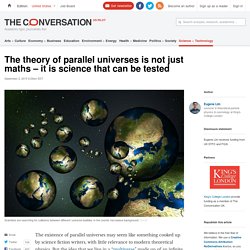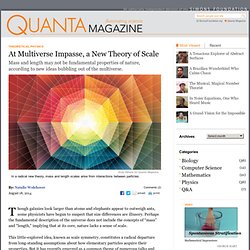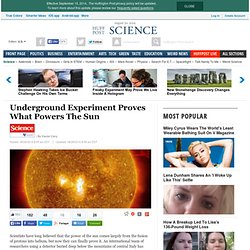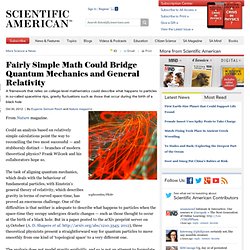

The theory of parallel universes is not just maths – it is science that can be tested. The existence of parallel universes may seem like something cooked up by science fiction writers, with little relevance to modern theoretical physics.

But the idea that we live in a “multiverse” made up of an infinite number of parallel universes has long been considered a scientific possibility – although it is still a matter of vigorous debate among physicists. The race is now on to find a way to test the theory, including searching the sky for signs of collisions with other universes. Everything Is Made Of Waves; Also, Particles - In Photos: Six Things Everyone Should Know About Quantum Physics. A Brief History of Everything, feat. Neil deGrasse Tyson. Is There A Mirror Universe? Large Hadron Collider prepares to reveal more secrets - BBC News. Spiders vs. the Sun. Which has a greater gravitational pull on me: the Sun, or spiders?

Granted, the Sun is much bigger, but it is also much further away, and as I learned in high school physics, the gravitational force is proportional to the square of the distance. —Marina Fleming Note: This is a spider-heavy article. I can be a little anxious about spiders myself, so my research for this article involved a lot of opening PDFs while squinting and leaning back from the screen. If you're a serious arachnophobe, you might want to skip this one. In the literal sense, this question is totally reasonable, although it would be easy to rephrase it to be completely incoherent. The gravitational pull from a single spider, no matter how heavy, will never beat out the Sun. Two quantum properties teleported together for first time. The values of two inherent properties of one photon – its spin and its orbital angular momentum – have been transferred via quantum teleportation onto another photon for the first time by physicists in China.

Previous experiments have managed to teleport a single property, but scaling that up to two properties proved to be a difficult task, which has only now been achieved. The team's work is a crucial step forward in improving our understanding of the fundamentals of quantum mechanics and the result could also play an important role in the development of quantum communications and quantum computers. Alice and Bob Quantum teleportation first appeared in the early 1990s after four researchers, including Charles Bennett of IBM in New York, developed a basic quantum teleportation protocol. The protocol has an observer, Alice, send information about an unknown quantum state (or property) to another observer, Bob, via the exchange of classical information. Sur Twitter : "Here's A Photo Of Something That Can't Be Photographed #science #physics. Here's A Photo Of Something That Can't Be Photographed.
[1408.2249] Mathematical Issues in Eternal Inflation. Immovable Object vs. Unstoppable Force - Which Wins? JMU Department of Physics and Astronomy. Matthew Feickert on Twitter: "Fabiola Gianotti is trending on #Twitter. This is beautiful. @CERN #physics... Matthew Feickert sur Twitter : "Fabiola Gianotti is trending on #Twitter. This is beautiful. @CERN #physics... Tech-FAQ sur Twitter : "What Happens In a Black Hole, Stays In a Black Hole #science #physics #humor...
Sur Twitter : "What Is the Universe? Real #Physics Has Some Mind-Bending Answers, by @VMJAGGARD99. What Is the Universe? Real Physics Has Some Mind-Bending Answers. To Avoid the Multiverse, Physicists Propose a Symmetry of Scales. Though galaxies look larger than atoms and elephants appear to outweigh ants, some physicists have begun to suspect that size differences are illusory.

Perhaps the fundamental description of the universe does not include the concepts of “mass” and “length,” implying that at its core, nature lacks a sense of scale. This little-explored idea, known as scale symmetry, constitutes a radical departure from long-standing assumptions about how elementary particles acquire their properties. But it has recently emerged as a common theme of numerous talks and papers by respected particle physicists. With their field stuck at a nasty impasse, the researchers have returned to the master equations that describe the known particles and their interactions, and are asking: What happens when you erase the terms in the equations having to do with mass and length? Nature, at the deepest level, may not differentiate between scales.
The new scale symmetry approach rewrites the beginning of that story. Einstein's Proof of E=mc² The Feynman Lectures on Physics. Plus.google. Sur Twitter : Not magic but #physics: What Happens When You Drop A Magnet Through A Copper Tube? What Happens When You Drop A Magnet Through A Copper Tube? Ahh, Physics, you never cease to astound me.

Today’s awesome science demo is brought to you by Lenz’s Law. Sur Twitter : Proved: sun power comes from the fusion of protons into helium, by @DanClery #physics. Underground Experiment Proves What Powers The Sun. Scientists have long believed that the power of the sun comes largely from the fusion of protons into helium, but now they can finally prove it.

Sur Twitter : Weird: Freaky #Physics Experiment May Prove Our Universe Is A Two-Dimensional Hologram. Freaky Physics Experiment May Prove Our Universe Is A Two-Dimensional Hologram. Everyone knows the universe exists in three dimensions, right?

Maybe not. For some time now serious physicists have been pondering the seemingly absurd possibility that three-dimensional space is merely an illusion--and that we actually live in a two-dimensional "hologram. " And now scientists at the Fermi National Accelerator Laboratory in Illinois have launched a mind-blowing experiment to show once and for all what sort of universe we live in. "We want to find out whether space-time is a quantum system just like matter is," Dr. Craig Hogan, director of Fermilab's Center for Particle Astrophysics, said in a written statement.
According to quantum theory's uncertainty principle, it's impossible to know both the precise location and the exact velocity of a subatomic particle. Five Reasons We Think Dark Matter Exists — Starts With A Bang! Michio Kaku: Is God a Mathematician? Fairly Simple Math Could Bridge Quantum Mechanics and General Relativity. From Nature magazine.

Could an analysis based on relatively simple calculations point the way to reconciling the two most successful — and stubbornly distinct — branches of modern theoretical physics? Frank Wilczek and his collaborators hope so. The task of aligning quantum mechanics, which deals with the behaviour of fundamental particles, with Einstein’s general theory of relativity, which describes gravity in terms of curved space-time, has proved an enormous challenge. A 34-Step Guide To String Theory, As Explained By Cats. Particle Measurement Sidesteps the Uncertainty Principle. Quantum mechanics imposes a limit on what we can know about subatomic particles.

If physicists measure a particle’s position, they cannot also measure its momentum, so the theory goes. But a new experiment has managed to circumvent this rule—the so-called uncertainty principle—by ascertaining just a little bit about a particle’s position, thus retaining the ability to measure its momentum, too. The uncertainty principle, formulated by Werner Heisenberg in 1927, is a consequence of the fuzziness of the universe at microscopic scales. Quantum mechanics revealed that particles are not just tiny marbles that act like ordinary objects we can see and touch. The Incredible Physics of Ants.
Nadia's post on Vine. #FollowFriday: Physicists to follow on Twitter. Sometimes a physics fan wants to know more than just the science headlines. Luckily, there’s another way to plug in to the particle physics community: Twitter. Hot water freezes faster than cold - and now we know why. Hot water seems to freeze faster than cold water, known as the Mpemba effect.

The effect was named after the Tanzanian student who in 1963 noticed that hot ice cream mix freezes faster than a cold one. The effect was first observed by Aristotle in the 4th century BC, then later Francis Bacon and René Descartes. Mpemba published a paper on his findings in 1969. Theories for the Mpemba effect have included: faster evaporation of hot water, therefore reducing the volume left to freeze; formation of a frost layer on cold water, insulating it; and different concentrations of solutes such as carbon dioxide, which is driven off when the water is heated.
What Happens To Liquid Nitrogen In A Vacuum? Liquid nitrogen is really amazing. It has a boiling point of -196 degrees Celsius (-321 degrees Fahrenheit), so it must be kept incredibly cold in order to exist as a liquid. In a vacuum chamber, the reduced pressure allows the nitrogen to boil more quickly. However, the evaporation process cools down the remaining nitrogen, allowing it to exist as a liquid.
When the temperature is brought down to -210 degrees Celsius (−346 degrees Fahrenheit), nitrogen will freeze and become a solid that looks like glass. The solid nitrogen then tries to force itself into a more tightly-packed configuration, and as the atoms begin the chain reaction of rearranging themselves, it creates flakes of snow that get shed off in the process. Seeing solid nitrogen is really rare, and seeing nitrogen snow is incredibly amazing.
Scientists create never-before-seen form of matter. Harvard and MIT scientists are challenging the conventional wisdom about light, and they didn't need to go to a galaxy far, far away to do it. Working with colleagues at the Harvard-MIT Center for Ultracold Atoms, a group led by Harvard Professor of Physics Mikhail Lukin and MIT Professor of Physics Vladan Vuletic have managed to coax photons into binding together to form molecules – a state of matter that, until recently, had been purely theoretical. The work is described in a September 25 paper in Nature. The discovery, Lukin said, runs contrary to decades of accepted wisdom about the nature of light. Photons have long been described as massless particles which don't interact with each other – shine two laser beams at each other, he said, and they simply pass through one another. "Photonic molecules," however, behave less like traditional lasers and more like something you might find in science fiction – the light saber.
Conference User Presentations.
Other. Quantum Physics. Astronomy & Astrophysics.